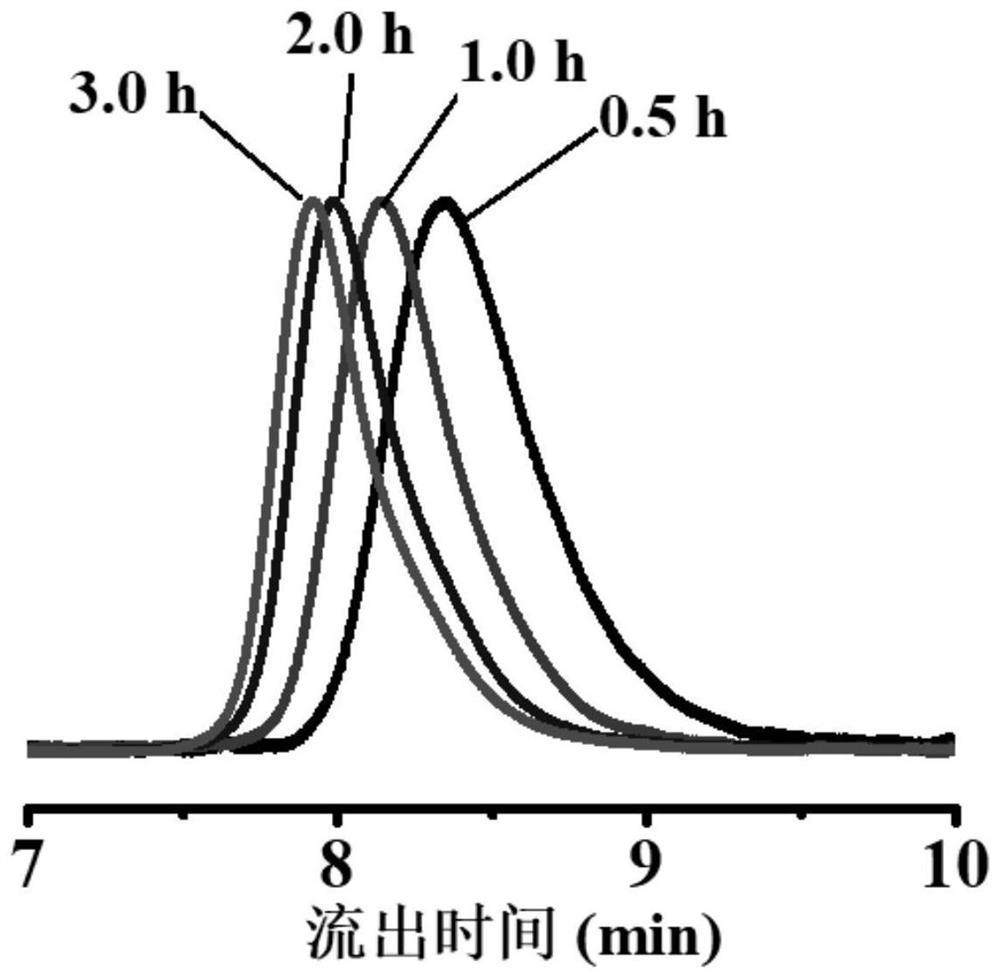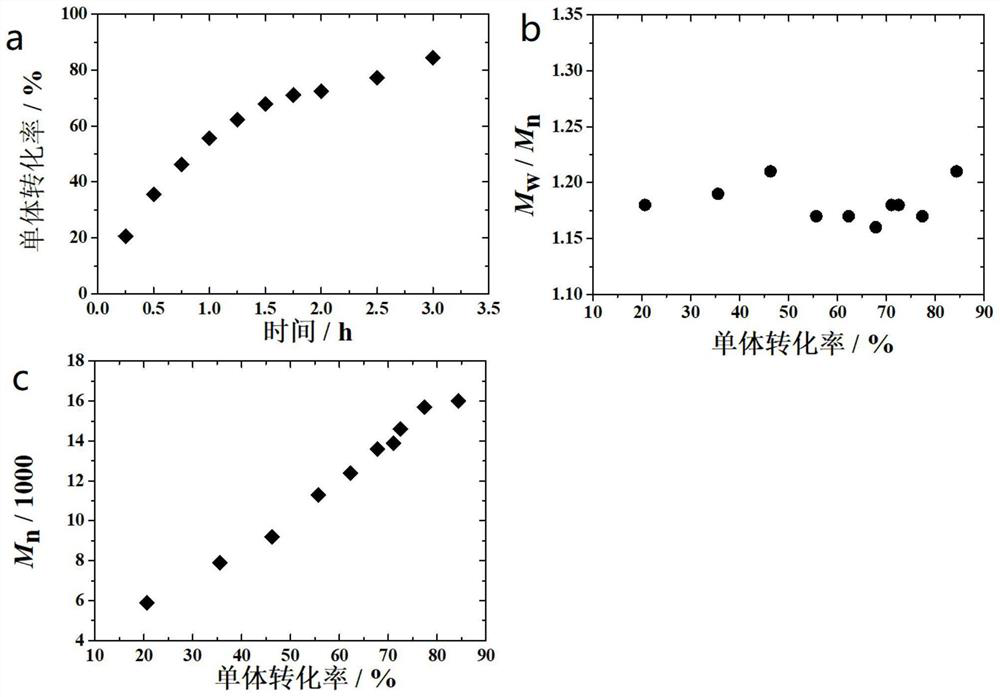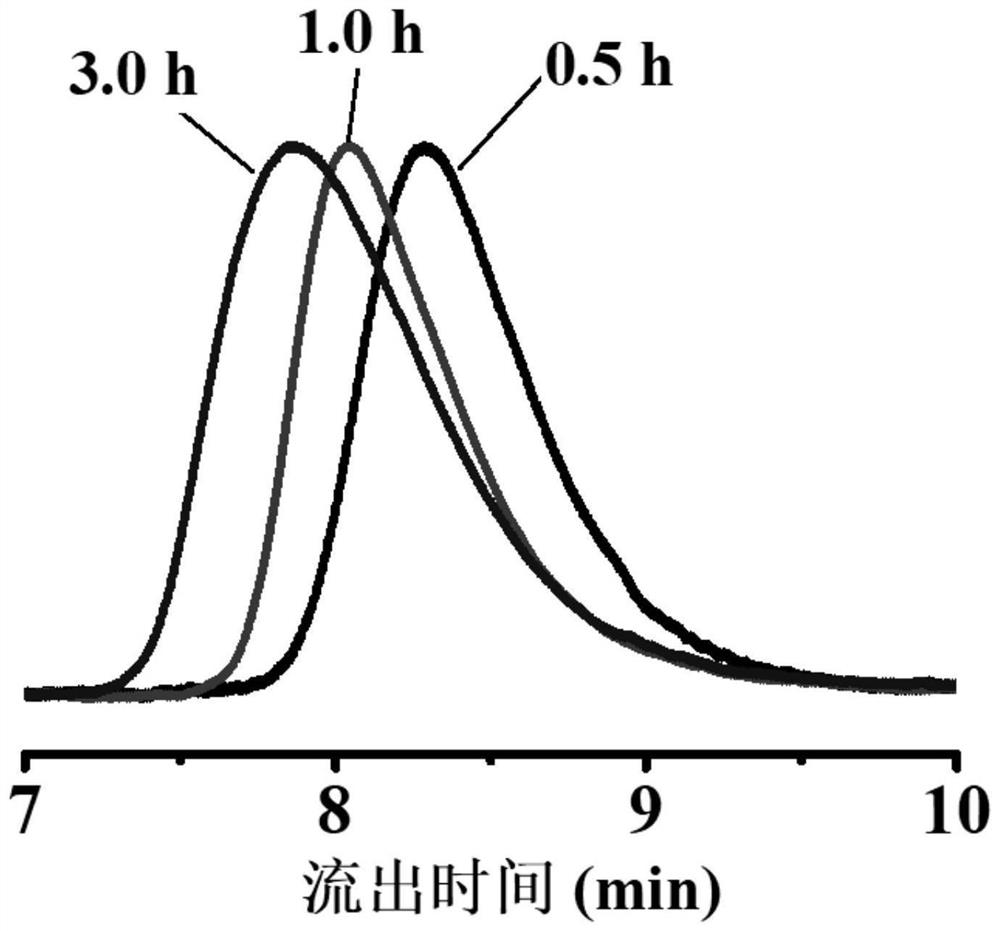Method for regulating and controlling dispersity of product of reversible addition-fragmentation chain transfer polymerization method
A technology of fragmentation chain transfer and polymerization, which is applied in the field of reversible addition-fragmentation chain transfer polymerization, can solve the problems of not being diblock copolymers, etc., and achieve the effects of wide control range, easy use, and simple operation
- Summary
- Abstract
- Description
- Claims
- Application Information
AI Technical Summary
Problems solved by technology
Method used
Image
Examples
Embodiment 1
[0048] Embodiment one does not add chain terminator synthetic polymethyl methacrylate (PMMAS)
[0049] Multiple groups of experiments were carried out in parallel, and each group of experiments reacted at different times. The specific method is as follows:
[0050] Moore, [MMA] 0 :[MBr] 0 :[CPDB] 0 :[ACCN] 0 =200:0:1:0.2, sequentially add CPDB (0.0209g), ACCN (0.0046g), MMA (2.0mL) and DMF (2.0mL) in the 10mL ampoule, add a stirring bar, after 3 times of standard After the freeze-pump-thaw aeration cycle, seal the tube under an oxygen-free atmosphere. The sealed ampoule was placed in a magnetic stirrer at 110° C. for a predetermined time and the rotation speed was 600 rpm. After the reaction, take out the sealed tube, open the sealed tube, dissolve it with 2-5 mL of tetrahydrofuran, pour it into 250 mL of methanol, leave it overnight, filter it with suction, and dry it to obtain polymethyl methacrylate (PMMA).
[0051] figure 1 For not adding under the condition of chai...
Embodiment 2
[0054] Example two sample molar ratio monomer: chain terminator: chain transfer agent=200:5:1 synthetic polymethyl methacrylate
[0055] Multiple groups of experiments were carried out in parallel, and each group of experiments reacted at different times. The specific method is as follows:
[0056] Moore, [MMA] 0 :[MBr] 0 :[CPDB] 0 :[ACCN] 0 =200:5:1:0.2, sequentially add MBr (0.0830g), CPDB (0.0209g), ACCN (0.0046g), MMA (2.0mL) and DMF (2.0mL) in a 10mL ampoule, add a stirring bar , after 3 standard freeze-pump-thaw inflation cycles, seal the tube under an oxygen-free atmosphere. The sealed ampoule was placed in a magnetic stirrer at 110° C. for a predetermined time and the rotation speed was 600 rpm. After the reaction is over, take out the sealed tube, open the sealed tube, dissolve it with 2-5 mL of tetrahydrofuran, pour it into 250 mL of methanol, leave it overnight, filter it with suction, and dry it to obtain polymethyl methacrylate.
[0057] image 3 For adding...
Embodiment 3
[0060] Embodiment three sample molar ratio monomer: chain terminator: chain transfer agent=200:10:1 synthetic polymethyl methacrylate
[0061] Multiple groups of experiments were carried out in parallel, and each group of experiments reacted at different times. The specific method is as follows:
[0062] Moore, [MMA] 0 :[MBr] 0 :[CPDB] 0 :[ACCN] 0 =200:10:1:0.2, sequentially add MBr (0.1660g), CPDB (0.0209g), ACCN (0.0046g), MMA (2.0mL) and DMF (2.0mL) to a 10mL ampoule, add a stir bar , after 3 standard freeze-pump-thaw inflation cycles, seal the tube under an oxygen-free atmosphere. The sealed ampoule was placed in a magnetic stirrer at 110° C. for a predetermined time and the rotation speed was 600 rpm. After the reaction is over, take out the sealed tube, open the sealed tube, dissolve it with 2-5 mL of tetrahydrofuran, pour it into 250 mL of methanol, leave it overnight, filter it with suction, and dry it to obtain polymethyl methacrylate.
[0063] Figure 5 For ad...
PUM
| Property | Measurement | Unit |
|---|---|---|
| Molecular weight | aaaaa | aaaaa |
| Molecular weight | aaaaa | aaaaa |
| Molecular weight | aaaaa | aaaaa |
Abstract
Description
Claims
Application Information
 Login to View More
Login to View More - R&D
- Intellectual Property
- Life Sciences
- Materials
- Tech Scout
- Unparalleled Data Quality
- Higher Quality Content
- 60% Fewer Hallucinations
Browse by: Latest US Patents, China's latest patents, Technical Efficacy Thesaurus, Application Domain, Technology Topic, Popular Technical Reports.
© 2025 PatSnap. All rights reserved.Legal|Privacy policy|Modern Slavery Act Transparency Statement|Sitemap|About US| Contact US: help@patsnap.com



